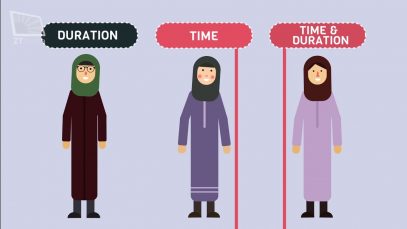Ahkam in Brief – Prerequisites for prayer
[The Script]
AHKAM in Brief – Prerequisites for prayer
Before prayers can be performed, preparation is needed. In other words, there are certain prerequisites for prayer, which are:
Timing, Qibla, Location, Dress, Wudhu and Ghusl.
In this video we will try to introduce each of these prerequisites briefly:
The first is ascertaining the timing: each one of our daily prayers has its own distinct time during the day. And they should be performed within their allocated times.
You have to be certain that the time for a specific prayer has started. This can be by hearing the sound of the Adhan with your own ears, or by checking the prayer time table from a trusted source.
Or, it could even be by using an application whose authenticity you trust.
Once again, it is essential that you reach certainty it is the right time to pray the intended prayer.
The time for Fajr prayer is from True dawn till sunrise, while for Zohr and Asr, is from the time when the sun starts declining till sunset. And for Maghrib and Isha is from sunset till the middle of the night.
The second prerequisite is determining the Qibla; all muslims should face towards the holy Kaba in the city of Mecca while praying.
You can find the direction of Qibla by seeing a sign that you trust, or by asking a trusted person, or even by using a device in which you trust its result.
The third prerequisite relates to the place where you are performing your prayers. It should not be usurped. Therefore, you cannot perform your prayer in a place where the owner doesn’t allow you to be.
In addition, the place where you put your forehead in Sajda, should be Tahir or ritually clean, and not Najis. Although the area surrounding your prayer place might be najis, it is essential that Najasah shouldn’t transmit to your body or dress.
Number four concerns the dress of the person, and should meet these criteria:
- For men it should cover the private parts. For ladies it should cover all the body except the face, hands and feet.
Note: in the presence of non-Mahram man, ladies should also cover their feet as it is part of their Hijab. - The dress should be Tahir and not Najis
- The dress should not be usurped
- It should not be made from the Najis dead bodies. for example, clothes should not be made from sheep leather which wasn’t slaughtered according to the Islamic laws.
- It should also not contain parts of a wild beast, such as fox fur, for example, even if it is Tahir.
- Men are not allowed to wear pure silk.
- finally, it is forbidden for men to wear gold
The fifth prerequisite is having Wudhu and Ghusl. it is essential to conduct Wudhu before starting prayer.
Also, if you are obliged to do Ghusl, such as Ghusl al-Janabah, you have to do Ghusl before performing the prayers.
In some cases, the Ghusl can substitute for Wudhu. For more information watch our Wudhu, Ghusl and Tayammum clips.
By observing these prerequisites, you’ll be ready to perform the daily prayer.








